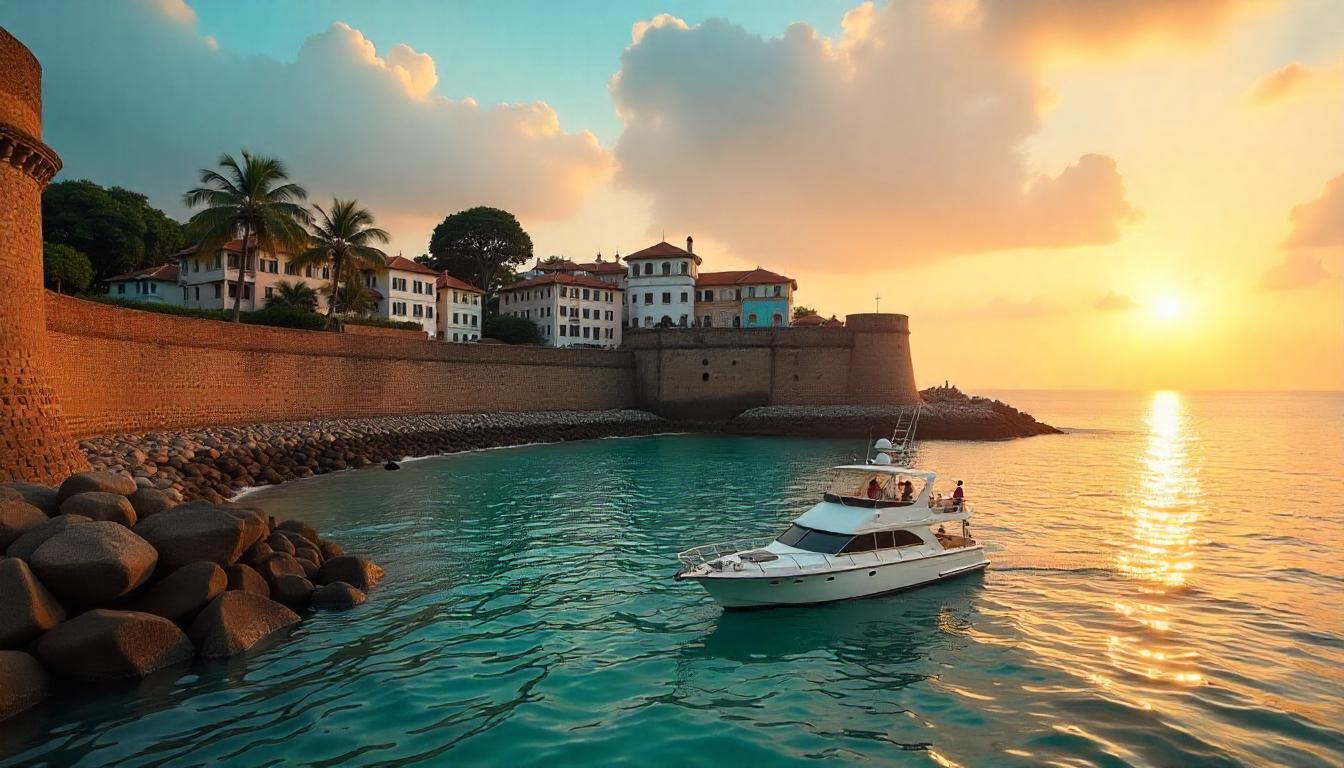Яхтинг на Шрі-Ланці пропонує неперевершений досвід дослідження одного з найприголомшливіших напрямків в Індійському океані. Відома як "Перлина Індійського океану", Шрі-Ланка є скарбницею природної краси, багатої культури та яскравого морського життя. Для яхтсменів цей тропічний рай надає нескінченні можливості відкрити для себе приховані бухти, незаймані пляжі і галасливі прибережні міста. Давайте заглибимося в те, що робить яхтинг на Шрі-Ланці такою незабутньою пригодою.
1. Чому варто обрати яхтинг на Шрі-Ланці?
1.1 Тропічний рай
Берегова лінія Шрі-Ланки простягається більш ніж на 1300 кілометрів, пропонуючи різноманітні ландшафти від золотистих пісків до пишних мангрових заростей. Яхтинг на Шрі-Ланці дозволяє отримати доступ до відокремлених бухт і віддалених островів, які часто недоступні наземним транспортом.
Крім того, теплі води та сприятливі погодні умови роблять регіон ідеальним для цілорічних досліджень.
1.2 Культурна та історична перлина
Яхтинг на Шрі-Ланці - це не лише краєвиди, а й подорож крізь історію та культуру. Острів є домом для стародавніх храмів, колоніальної архітектури та яскравих фестивалів, які відображають його багату спадщину.
Вивчення цих культурних пам'яток під час плавання вздовж узбережжя додає глибини і сенсу вашій яхтової подорожі.
2. Ключові виклики яхтингу на Шрі-Ланці
2.1 Погодні умови
Однією з головних проблем яхтингу на Шрі-Ланці є сезон мусонів. Південно-західний мусон (з травня по вересень) впливає на західне і південне узбережжя, в той час як північно-східний мусон (з листопада по лютий) впливає на східне узбережжя.
Щоб забезпечити безперешкодну подорож, плануйте свій маршрут відповідно до сезону і регулярно стежте за прогнозами погоди.
2.2 Обмежені можливості
Хоча туристична інфраструктура Шрі-Ланки покращується, деяким прибережним районам все ще бракує сучасних пристаней для яхт і ремонтних майстерень. Яхтсмени повинні покладатися на власні сили і мати при собі необхідні запаси, включаючи паливо, їжу та засоби безпеки.
Ця віддаленість, однак, додає шарму, пропонуючи можливість відключитися від сучасного життя і зануритися в природу.
3. Поради щодо яхтингу на Шрі-Ланці
3.1 Сплануйте свій маршрут з розумом
Перш ніж вирушати в плавання, складіть детальний маршрут, враховуючи сезонні погодні умови та місцеві визначні пам'ятки. Серед популярних зупинок - Галле, Трінкомалі та Мірісса, але не забувайте про приховані перлини, такі як Калпітія або Пасікуда.
Подумайте про поїздку в сухий сезон для кожного регіону - грудень-квітень ідеально підходить для західного і південного узбережжя, а травень-вересень - для східного узбережжя.
3.2 Підготуйте яхту до пригод
Подорожуючи Шрі-Ланкою, переконайтеся, що ваша яхта обладнана для тропічних умов. Візьміть з собою додаткові припаси, інструменти для дрібного ремонту та надійні навігаційні інструменти, такі як GPS і карти.
Крім того, інвестуйте в екологічно чисті продукти, щоб мінімізувати свій вплив на навколишнє середовище під час дослідження цього незайманого місця.
3.3 Поважайте місцеві звичаї та правила
Шрі-Ланка - культурно багата країна з глибоко вкоріненими традиціями. Завжди поважайте місцеві звичаї, одягайтеся скромно під час відвідування релігійних місць і шанобливо спілкуйтеся з місцевими жителями.
Ознайомтеся з місцевими правилами, такими як заборонені зони риболовлі та правила постановки на якір, щоб забезпечити безпечну та відповідальну подорож.

4. Мальовничі моменти яхтингу на Шрі-Ланці
4.1 Галле та його історичний форт
Галле - об'єкт Всесвітньої спадщини ЮНЕСКО, відомий своїм історичним фортом і чарівними вуличками. Під час яхтової подорожі Шрі-Ланкою це портове місто є ідеальною зупинкою для знайомства з голландською колоніальною архітектурою, бутіками та жвавими кафе.
Ви можете кинути якір неподалік і неспішно прогулятися фортом, насолоджуючись його вічним шармом.
4.2 Мірісса та спостереження за китами
Мірісса - популярне місце серед яхтсменів, які шукають пригод. Відоме своїми можливостями для спостереження за китами, це прибережне містечко пропонує шанс побачити синіх китів, кашалотів і дельфінів у їхньому природному середовищі існування.
Кинувши якір тут, ви зможете насолодитися спокоєм пляжу, готуючись до незабутнього морського сафарі.
5. Приховані перлини Шрі-Ланки
5.1 Півострів Кальпітія
Півострів Калпітія - це прихована перлина для яхтсменів, що пропонує незаймані пляжі, коралові рифи та багату дику природу. Цей регіон особливо відомий завдяки кайтсерфінгу та спостереженню за дельфінами.
Дослідження Кальпітії на яхті дає відчуття ексклюзивності, оскільки вона залишається відносно незайманою масовим туризмом.
5.2 Національний парк "Голубиний острів
Національний парк Pigeon Island, розташований неподалік від Трінкомалі, є раєм для любителів сноркелінгу та дайвінгу. Парк є домом для яскравих коралових рифів, різнокольорових риб і навіть чорноперих рифових акул.
Кинувши якір неподалік, ви зможете зануритися в кришталево чисті води і дослідити підводні чудеса цієї заповідної зони.
6. Ресторани та розважальні заклади
Місцева кухня
Шрі-Ланка відома своєю вишуканою кухнею, що поєднує спеції та свіжі інгредієнти. Спробуйте місцеві делікатеси, такі як хопери (млинці у формі чаші), котту роті (смажені коржі) та каррі з морепродуктів.
У багатьох прибережних містах також є ресторани на пляжі, де ви можете насолодитися свіжим уловом дня, милуючись приголомшливим видом на океан.
Нічне життя та події
Хоча Шрі-Ланка не відома своїм нічним життям, її чарівність полягає в тихих задоволеннях. Відвідайте традиційні танцювальні вистави, дослідіть місцеві ринки або просто розслабтеся на палубі яхти під зоряним небом.
Під час таких фестивалів, як Esala Perahera в Канді, ви можете стати свідком яскравих процесій і культурних святкувань.
7. Висновок: Прийміть пригоди
Яхтинг на Шрі-Ланці у 2025 році - це пригода, що поєднує в собі природну красу, культурне багатство та захоплюючі враження. Хоча це і пов'язано з певними труднощами, належна підготовка та дбайливе ставлення до навколишнього середовища можуть забезпечити безпечну та корисну подорож.
Тож прокладіть свій курс, пориньте у хвилювання яхтингу на Шрі-Ланці та створіть спогади, які залишаться на все життя.


